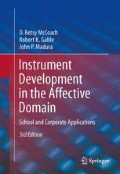Abstract
The purpose of Chapter 8 is to synthesize all of the technical and methodological elements discussed throughout this book into a series of recommended guidelines. Throughout the chapter, the major development themes are highlighted in way that allows researchers to refer back to preceding chapters for more detailed explanations of the step at hand. This chapter also helps to alert the reader to many “application” challenges that are typically not addressed in theoretical discussions of instrument development and design. Important, but previously unaddressed practical topics such as formatting, writing survey directions, the inclusion of demographic information, as well as the process of piloting an instrument are discussed in this final section. Ultimately, this final chapter should serve as a summary of the “best practices” used by researchers concerned with developing the most effective and efficient instrument for measuring affective characteristics.
Access this chapter
Tax calculation will be finalised at checkout
Purchases are for personal use only
References
American Educational Research Association (AERA), American Psychological Association (APA), & National Council on Measurement in Education (NCME). (1999). The standards for educational and psychological testing. Washington, DC: American Educational Research Association.
Dale, E., & Chall, J. (1948, January). A formula for predicting reliability. Educational Research Bulletin, 27, 11–20.
Kincaid, J. P., Fishburne, R. P., Rogers, R. L., & Chissom, B. S. (1975). Derivation of New Readability Formulas (Automated Readability Index, Fog Count, and Flesch Reading Ease formula) for Navy Enlisted Personnel. Research Branch Report 8–75. Chief of Naval Technical Training: Naval Air Station Memphis.
Likert, R. (1932). A technique for the measurement of attitudes. Archives of Psychology, 140, 152.
Pett, M. A., Lackey, N. R., & Sullivan, J. J. (2003). Making sense of factor analysis: The use of factor analysis for instrument development in health care research. Thousand Oaks, CA: Sage.
Spache, G. (1953). A new readability formula for primary grade reading materials. Elementary School Journal, 53, 410–413.
Author information
Authors and Affiliations
Corresponding author
Rights and permissions
Copyright information
© 2013 Springer Science+Business Media New York
About this chapter
Cite this chapter
McCoach, D.B., Gable, R.K., Madura, J.P. (2013). Review of the Steps for Designing an Instrument. In: Instrument Development in the Affective Domain. Springer, New York, NY. https://doi.org/10.1007/978-1-4614-7135-6_8
Download citation
DOI: https://doi.org/10.1007/978-1-4614-7135-6_8
Published:
Publisher Name: Springer, New York, NY
Print ISBN: 978-1-4614-7134-9
Online ISBN: 978-1-4614-7135-6
eBook Packages: Behavioral ScienceBehavioral Science and Psychology (R0)

